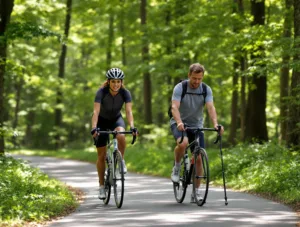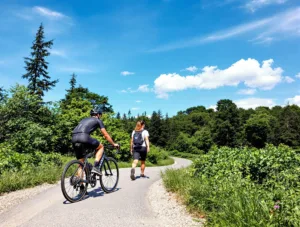Does Cycling Help Get Rid of Belly and Butt Fat? The Truth About Targeted Fat Loss
Introduction
In the quest for a slimmer waistline and a toned lower body, many people turn to cycling as a potential solution. But does cycling really help burn belly and butt fat, or is it just another fitness myth? The idea of “spot reduction” – losing fat from specific areas through targeted exercises – has long been debated in the fitness world. While cycling is an excellent cardiovascular workout that promotes overall fat loss, its direct impact on stubborn fat deposits in the belly and butt requires a deeper understanding of how the body burns fat.
This article explores the science behind fat loss, the effectiveness of cycling for reducing belly and butt fat, and how to maximize results through proper training, nutrition, and complementary exercises. Whether you’re a casual rider or a dedicated cyclist, understanding these principles will help you achieve a leaner, more sculpted physique.
The Science of Fat Loss: Can You Target Specific Areas?
Understanding Fat Storage and Metabolism
The human body stores fat in adipose tissue, which is distributed based on genetics, hormones, and lifestyle factors. Men tend to accumulate fat around the abdomen (visceral fat), while women often store more fat in the hips, thighs, and buttocks (subcutaneous fat).
A common misconception is that exercising a specific body part will burn fat from that area. However, fat loss occurs systemically—meaning the body draws energy from fat stores throughout the body, not just the muscles being worked.
The Myth of Spot Reduction
Multiple studies have debunked spot reduction. A 2013 study published in the Journal of Strength and Conditioning Research found that participants who performed abdominal exercises for six weeks showed no significant reduction in belly fat compared to a control group. Similarly, cycling primarily engages the lower body but doesn’t exclusively burn fat from the legs or butt.
Instead, fat loss depends on:
- Caloric deficit (burning more calories than consumed)
- Hormonal balance (insulin, cortisol, and sex hormones influence fat storage)
- Exercise intensity and consistency
Cycling for Fat Loss: How Effective Is It?
Cycling is a highly efficient cardiovascular exercise that burns calories, improves endurance, and strengthens the lower body. But how well does it contribute to fat loss in stubborn areas like the belly and butt?
Calorie Burn and Fat Reduction
The number of calories burned while cycling depends on:
- Intensity: A vigorous ride (16-20 mph) can burn 600-1000 calories per hour.
- Duration: Longer rides increase total energy expenditure.
- Body weight: Heavier individuals burn more calories at the same intensity.
Since fat loss requires a caloric deficit, cycling can help create that deficit when combined with a balanced diet.
Impact on Belly Fat
While cycling doesn’t directly target belly fat, it helps reduce overall body fat, including visceral fat. High-intensity cycling, such as interval training, has been shown to be particularly effective in reducing abdominal fat. A 2018 study in the Journal of Diabetes Research found that HIIT (High-Intensity Interval Training) significantly decreased visceral fat in participants.
Impact on Butt Fat
Cycling engages the glutes, hamstrings, and quadriceps, which can lead to muscle toning. However, if fat loss isn’t prioritized through diet and overall exercise, the butt may appear larger due to muscle growth under fat. To achieve a leaner look, a combination of fat loss and strength training is essential.
Maximizing Fat Loss Through Cycling
To optimize cycling for fat loss, consider the following strategies:
1. Incorporate High-Intensity Interval Training (HIIT)
- Alternate between sprints (30-60 seconds) and recovery periods (1-2 minutes).
- HIIT boosts metabolism and promotes post-exercise fat burning (EPOC – Excess Post-Exercise Oxygen Consumption).
2. Increase Ride Duration and Frequency
- Longer rides (90+ minutes) at moderate intensity enhance fat oxidation.
- Aim for at least 3-5 cycling sessions per week for consistent results.
3. Combine Cycling with Strength Training
- Strength exercises (squats, lunges, deadlifts) help build muscle, increasing resting metabolic rate.
- More muscle mass = higher calorie burn even at rest.
4. Optimize Nutrition for Fat Loss
- Prioritize protein to preserve muscle mass.
- Reduce refined carbs and sugars to prevent fat storage.
- Stay hydrated to support metabolism.
Complementary Exercises for Belly and Butt Fat Reduction
While cycling is effective, combining it with other exercises enhances fat loss and muscle definition:
For Belly Fat:
- Planks and core workouts (strengthen muscles but don’t directly burn fat)
- Cardio variations (running, swimming, rowing)
- Full-body strength training (kettlebell swings, burpees)
For Butt Fat and Toning:
- Squats and lunges (build glute muscles)
- Hip thrusts and deadlifts (target the posterior chain)
- Stair climbing (mimics cycling but with resistance)
Final Verdict: Does Cycling Help Reduce Belly and Butt Fat?
Cycling is an excellent tool for overall fat loss, including reductions in belly and butt fat—but only when combined with a proper diet and full-body fitness approach. It won’t “spot reduce” fat in these areas alone, but it contributes to a caloric deficit and improves muscle tone.
Key Takeaways:
✅ Cycling burns calories and aids in fat loss, but spot reduction is a myth.✅ High-intensity cycling (HIIT) is particularly effective for reducing visceral fat.✅ Strength training and nutrition are crucial for shaping the glutes and abs.✅ Consistency and a holistic approach yield the best results.
For those aiming to slim down their midsection and lower body, cycling should be part of a broader fitness strategy that includes resistance training, a balanced diet, and varied cardio. By understanding how fat loss works and applying these principles, you can achieve a leaner, stronger physique—both on and off the bike.
Final Advice
If your goal is to lose belly and butt fat, don’t rely solely on cycling. Instead:
- Mix cycling with HIIT and strength training.
- Maintain a slight caloric deficit with a high-protein diet.
- Stay consistent and patient—fat loss takes time.
With the right approach, cycling can be a powerful component of your fat-loss journey, helping you achieve a toned, healthy body. 🚴♂️💪









Add comment